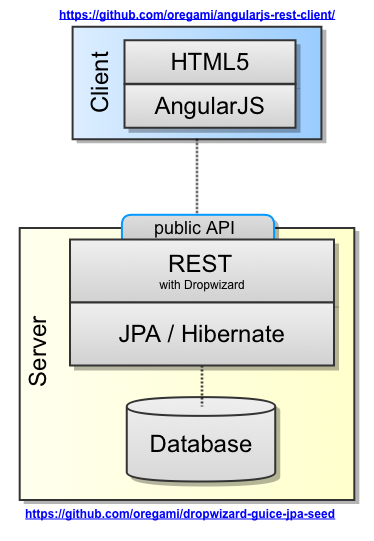This a sample REST application written in Java. It's purpose is to create a generic project that can be used as a starting point for a new project, but also for learning efforts (I am building an open game database at www.oregami.org).
- built on Dropwizard version 0.7.0
- dependency injection with Google Guice (no Spring dependencies!)
- Hibernate / JPA 2.1 as database access framework
- HSQLDB as database
- read database configuration from Dropwizard yaml config file, persistence.xml is not used
- "Session-per-HTTP-request" with Guice PersistentFilter
- suport for cross-origin resource sharing
- JPA entities with UUIDs as primary keys
- Auditing/Version control of entities with hibernate envers
- authentication with JSON Web Token via dropwizard-auth-jwt
- Integration tests with rest-assured
- a pattern for accessing and manipulation entities with HTTP REST calls (Resource => Service => DAO => entity)
- a pattern for ServiceResult objects which contain ServiceErrorMessages (which can later be bound to web form fields in the client)
Feel free to suggest corrections, optimizations or extensions via pull requests!
A corresponding JavaScript client application (AngularJS) is available at https://github.com/oregami/angularjs-rest-client/
- more complex entities
- hypermedia / HATEOAS
-
Start the application with the class "ToDoApplication" with the parameters "server todo.yml".
-
List all tasks with:
GET => http://localhost:8080/task -
Add a new task with:
POST => http://localhost:8080/taskHeader:
Content-Type:application/jsonJSON-Body e.g. :
{"name" : "task 1", "description" : "This is a description"} -
Modify a task:
PUT => http://localhost:8080/task/[id]Header:
Content-Type:application/json Accept:application/jsonJSON-Body e.g.:
{ "id": "402880944687600101468760d9ea0000", "version": "0", "name": "task 1 with new name", "description": "This is an updated description", "finished": "false" } -
Remove a task:
DELETE => http://localhost:8080/task/[id] -
List all revision numbers of a task with:
GET => http://localhost:8080/task/[id]/revisions -
Show a single task with:
GET => http://localhost:8080/task/[id] -
Show a special revision of a single task with:
GET => http://localhost:8080/task/[id]/revisions/[revisionNumber] -
Create JSON Web Token for authentication:
POST => http://localhost:8080/jwt/login?username=[username]&password=[password] e.g. with user1/password1 or user2/password2 -
Check if your JSON Web Token is valid for authentication:
GET => http://localhost:8080/jwt/test Authentication-Header: "Bearer [token]"
I recommend you use the great chrome extension Postman to make such HTTP calls!

